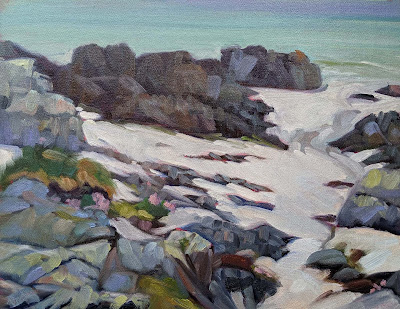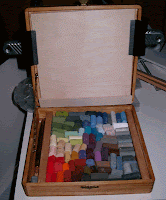NOTE: My Tuesday Zoom class is sold out. If you’re interested I’m waitlisting another class for Monday evenings starting May 18.
 |
| Sunset sail, by Carol L. Douglas. Available through Folly Cove Fine Art. |
I could avoid the struggle of redefining my work and teaching while in Argentina, but once home, it hit me at gale force. It didn’t help that I spent five weeks battling an intestinal bug. Every event, workshop and class I’d meticulously planned for this summer was either cancelled, postponed, or in limbo. Suddenly, I had no business plan at all.
Last week I accepted paintings back from two galleries that have quietly closed their doors. Both were suffering from pre-existing conditions, or what I’ve taken to calling ‘business co-morbidities.’ I’m seeing that a lot right now. This crisis may end up being like a spring ice storm that does Nature’s severe pruning. They’re scary but lead to a healthier forest. However, they also leave tremendous short-term damage. In human lives, that translates to heartache.
I’ve started spending Sundays listening to my friends preach. Bill Carpenter talked about how hard this shutdown is for kinesthetic learners. That’s me, so a piece of the puzzle slotted into place. Then our own Tommy Faulk talked about using this time to ask why we’re doing what we’re doing. Maybe I’ve been looking at this all wrong. Maybe this time is a gift, an opportunity for a reset.
 |
| White Sands of Iona, by Carol L. Douglas. |
Mary Byrom is weeks ahead of me in transitioning to teaching online. She listened carefully as I laid out all my frustrations. Mary’s a great teacher, so I wasn’t surprised that her solution was lucid and simple. I already had all the tools I needed; it was really a question of adapting them to this new medium of Zoom.It took no time for me to put her suggestions into practice. Tuesday’s class (which was the last one of my current session) was a joy to teach. If the feedback I got is any indication, it was good for the students, too. So, yes, we’ll have another online session and hope that the need for social distancing is gone by the time it ends.
 |
| The Alaska Range, by Carol L. Douglas |
We meet on Tuesdays from 10 to 1, on the following dates:
- May 12
- May 19
- May 26
- June 2
- June 9
- June 16
I’ve had two people joining me from out of town during the last session. That made me realize that you don’t need to be in Maine to take this class. That means my old students from New York or my former workshop students can join me.
We still stress the same subjects as we would do outdoors:
- Color theory
- Accurate drawing
- Mixing colors
- Finding your own voice
- Authentic brushwork
We utilize painting protocols to get you to good results with the least amount of wasted time. That means drawing, brushwork and color. I’m not interested in creating carbon copies of my style; I’m going to nurture yours, instead. However, you will learn to paint boldly, using fresh, clean color. You’ll learn to build commanding compositions, and to use hue, value and line to draw the eye through your paintings.
 |
| Beach erosion, by Carol L. Douglas. Available through Ocean Park Association. |
Watercolor, oils, pastels, acrylics and—yes, even egg tempera—are all welcome. Because it’s a small group, I can work with painters of all levels. The fee is $200 for the six-week session.
As with all my classes, this class is strictly limited to twelve people. Email me for more information and supply lists.



